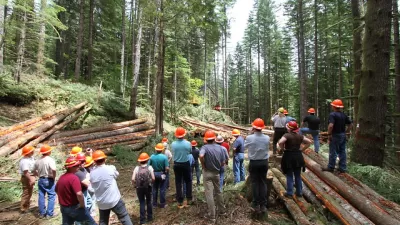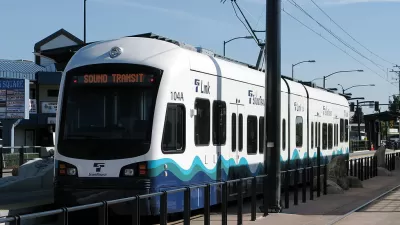Cross-laminated timber offers a multitude of environmental and economic benefits. With the state’s resources and Seattle’s construction needs, the city is the ideal location for mass timber production to take off.

"With vast timber resources and ready for retrofit facilities, the Pacific Northwest has an opportunity to lead a revolution in sustainable building and with the major challenges Seattle is facing around housing affordability and homelessness, our city can and should be at the center of demand for mass timber," writes Conor Bronsdon.
Cross-laminated timber is an ideal alternative to steel and concrete, argues Bronsdon. It performs well as a construction material, can be assembled quickly and easily at construction sites, and requires much less energy for production than steel.
Bronsdon notes that developments at the state and national levels are making cross-laminated timber a more viable option:
The passage of the Timber Innovation Act, officially signed into law in December as part of the national Farm Bill, is a big step for incentivizing the use of CLT. One of the most important provisions of the bill is that it provides annual matching grants to advance innovation in wood construction including prioritizing the use of funds to retrofit sawmills in areas of high unemployment.
He says this is an opportunity to revitalize the flagging economies of rural Washington communities dependent on the timber industry. Washington also last year changed its state building code to allow for mass timber to be used in taller buildings.
Bronsdon says that a partnership between environmental groups and the timber industry would encourage sustainable in-state production. "With responsible and economically incentivized forest management, we can change the calculus of deforestation, encourage replanting and continued harvesting as younger and lower grade trees can be used in mass timber products such as CLT."
FULL STORY: Seattle Should Lead on Mass Timber–and Solve Our Housing Crisis

Trump Administration Could Effectively End Housing Voucher Program
Federal officials are eyeing major cuts to the Section 8 program that helps millions of low-income households pay rent.

Planetizen Federal Action Tracker
A weekly monitor of how Trump’s orders and actions are impacting planners and planning in America.

Ken Jennings Launches Transit Web Series
The Jeopardy champ wants you to ride public transit.

Crime Continues to Drop on Philly, San Francisco Transit Systems
SEPTA and BART both saw significant declines in violent crime in the first quarter of 2025.

How South LA Green Spaces Power Community Health and Hope
Green spaces like South L.A. Wetlands Park are helping South Los Angeles residents promote healthy lifestyles, build community, and advocate for improvements that reflect local needs in historically underserved neighborhoods.

Sacramento Plans ‘Quick-Build’ Road Safety Projects
The city wants to accelerate small-scale safety improvements that use low-cost equipment to make an impact at dangerous intersections.
Urban Design for Planners 1: Software Tools
This six-course series explores essential urban design concepts using open source software and equips planners with the tools they need to participate fully in the urban design process.
Planning for Universal Design
Learn the tools for implementing Universal Design in planning regulations.
Heyer Gruel & Associates PA
Ada County Highway District
Institute for Housing and Urban Development Studies (IHS)
City of Grandview
Harvard GSD Executive Education
Toledo-Lucas County Plan Commissions
Salt Lake City
NYU Wagner Graduate School of Public Service





























